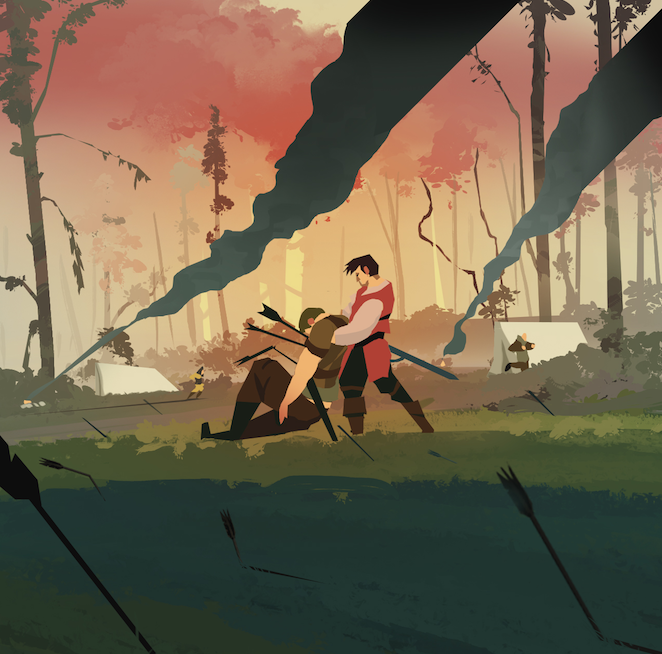The True Cost of Adding Story to a Game
Before I wrote a line of code, I knew that I wanted my game to have a story. And, of course, not just any story. It had to be a decent story with sound, art, movement and voice overs. Basically, a movie. Now that I’m 75% through the process of creating and implementing a story, I thought I’d share some lessons learned about this surprisingly difficult task that cost me around $7,600 and nearly 3 months of my development time.
Quick scale note to provide perspective — my story is ~13 minutes long, and contains ~250 sentences of dialogue over 20 illustrations. Your mileage will vary, but this will hopefully provide some insight that you can plan against.
Writing
I’ve been writing technical posts for years now. If you combine my Particletree days with the thousands of Wufoo support emails I’ve written, I might qualify as a professional writer. How does that translate to story? It doesn’t. Writing a story is hard, so be prepared to iterate early and often.
To get started, I took inspiration from other sources. Reading that post again shows me just how naive I was less than a year ago. Take this quote:
Perhaps the best part of story telling is that very little development time is required.
I can only laugh at how far from the truth that statement is. The time sink begins with writing. Up until now, I’ve written 4 drafts of script. Between rewrites, edits, formatting, talking to your wife and dreaming about it, it is safe to say this process will take at least 2 weeks of full time.
Friends & Editors
In addition to time spent writing in isolation, I highly recommend showing your script to friends and editors early in the process. Friends are usually free, but make sure that they’re willing to give harsh criticism. Fortunately, Brian Campbell was that person for me. He wrote an essay of feedback. Here is a small snippet.
Character / basic setting / dialogue / plot are pretty common as-is. Is there a way to introduce elements to the universe that help make it unique? Is their formal tone necessary? If so, within that, can you make the dynamic between the characters more complex / more human? What’s the motivation behind the attacks?
That, combined with his other feedback, forced me to figure out the world. Provide backstory, regions, conflicts, and more even if they aren’t mentioned in the final game. So, this big push of feedback helped me reshape the big picture. Next up, Mike Waterston helped me with the details as an editor.
Here's two of the many script improvements suggested by @mawaterston. Love having another set of eyes. #gamedev pic.twitter.com/FZSIAf70Ja
— Ryan Campbell (@veeneck) February 17, 2015
In addition to grammar and context improvements, Mike also acts as the valuable role of first viewer. I’ve been looking at the script so long that I know what happens and am oblivious to the issues. What is rushed or not explained well? What is conflicting? An editor will help work through those issues, and fill in the gaps.
As far as cost, plan to spend at least another week through back and forth along with $300+.
Art
I knew there would be a lot of art for the story, so I asked Scott to start with a “simplistic” style. By “simplistic”, I meant something that could be completed within a reasonable time frame and budget — ~$200 per scene. Have a look at an example illustration.

I don’t have too many data points, but I did speak to one other illustrator early on in the process. His pricing was around $200 for an easier illustration, and could go up to $500 depending on complexity. These numbers seem fair to me, and safe to base my assumptions off of.
I didn’t realize just how much of my time I would have to dedicate to these scenes. Who is in them? How are they positioned? What time of day? What’s in the background? As a quick example, I would have to think of the world map and the location to know what’s near. So, the world map needed to be roughed out. Then, where would the fight take place? I wanted varied terrains to keep it interesting. Once that was figured out, I could then give Scott a good idea of the scene and answer the detail questions. Some of these questions are answered in the script editing process, but I still spent a good hour or two for each illustration he created.
Overall, ~$4,000 on art and 1 week of my time.
Music
How hard can music be, right? You just send your story off to a composer and a masterpiece comes back. As you may have guessed by now, this takes time too. On your end, getting the story into a video format that is perfectly timed takes a bit of work. Also, plan to spend some time searching for music that you like, and some back and forth establishing the exact sound for your game. Finally, allow for iterations to timing so that key moments are properly built up.
As far as cost goes, I’ve found that indie rates, or rates for composer still establishing themselves, range around $100-$150 per minute. Professional rates can get up to $350-$700 per minute. That said, both parties are usually willing to license their past work at a more affordable price, and then only do custom work where needed. When budgeting, keep in mind that story work is usually more custom while battle tracks and menu screens are more generic.
All said and done, I’m looking at $1,300 for music and one week of my time.
Sound and Voice
Full disclosure — I haven’t finished this step yet. However, I have started discussions so I have a rough idea of what to expect. In terms of preparation, the script must be finished and the amount of voices must be known. Since a video of the story was prepared in the music step, and the script was finished in the writing step, no additional work is needed here.
For pricing, I’ve seen rates from $2,000 to $6,000 for 4 actors. Also, professional sound design rates for a project can range from $5,000 – $10,000. I’ve also seen sound designers willing to do voice for free if you use them for sound design. As an indie, this step is tricky, and I think finding the balance between quality and a studio friendly towards indies is necessary to keep the budget within reason.
I’m budgeting $2,000 for voice and sound, which does not include sound effects for actual gameplay (only story scenes).
Technical Implementation
Implementing a story has been quite tedious and time consuming. Some tasks are smaller, like figuring out where the text will appear and how it will look. Others are large, like creating an engine that can handle skippable cutscenes. You will also have to deal with how saved games view story, localizing your story, and adding life and movement to the scenes. In fact, it wasn’t long before I was looking at blogs advising tips for directors.
The initial pass, which included preloading code and scene switchboard code took 4 weeks. Granted, I would have had to written some of that even if I didn’t have a story, so I’ll only attribute two weeks to story. Now that a rough draft is implemented, I plan to spend another full day per scene on polish. In some cases, the polish will be as simple as changing camera motion or timing. In others, I’ll have to create a custom mask or effect to enhance the story.
For now I’ll estimate the total time around 6 weeks.
A disclaimer. This is my first time attempting a story. I’m not even sure if the end product will be good. The next time around may be more efficient. Who knows? I wrote this post because everyone tells you not to start a first person shooter or MMO for your first game. But, your rarely hear about the impact one smaller decision, like adding a story, will make to your timeline and budget.
Also, the time estimates take into account the lost productivity from interruptions. For example, when you start programming something, and then have to immediately change gears for an hour here or there to work on something story related. Because of the nature of programming, that hour always costs more than an hour.






Thank you
Your comment will be published once it has been approved.
to see the pull request you generated.